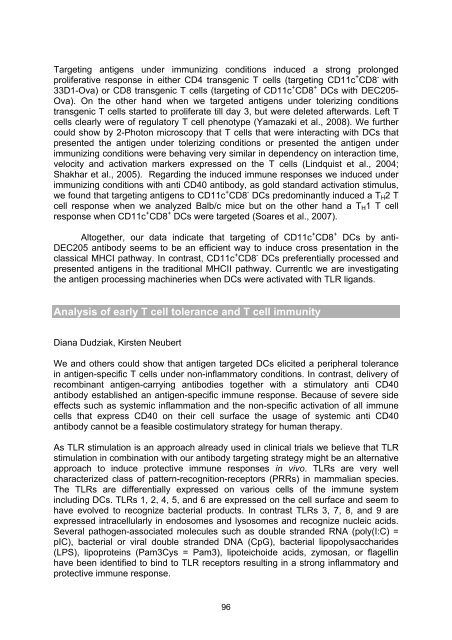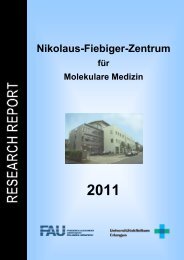Research Report - Nikolaus-Fiebiger-Zentrum für Molekulare Medizin
Research Report - Nikolaus-Fiebiger-Zentrum für Molekulare Medizin
Research Report - Nikolaus-Fiebiger-Zentrum für Molekulare Medizin
Create successful ePaper yourself
Turn your PDF publications into a flip-book with our unique Google optimized e-Paper software.
Targeting antigens under immunizing conditions induced a strong prolonged<br />
proliferative response in either CD4 transgenic T cells (targeting CD11c + CD8 - with<br />
33D1-Ova) or CD8 transgenic T cells (targeting of CD11c + CD8 + DCs with DEC205-<br />
Ova). On the other hand when we targeted antigens under tolerizing conditions<br />
transgenic T cells started to proliferate till day 3, but were deleted afterwards. Left T<br />
cells clearly were of regulatory T cell phenotype (Yamazaki et al., 2008). We further<br />
could show by 2-Photon microscopy that T cells that were interacting with DCs that<br />
presented the antigen under tolerizing conditions or presented the antigen under<br />
immunizing conditions were behaving very similar in dependency on interaction time,<br />
velocity and activation markers expressed on the T cells (Lindquist et al., 2004;<br />
Shakhar et al., 2005). Regarding the induced immune responses we induced under<br />
immunizing conditions with anti CD40 antibody, as gold standard activation stimulus,<br />
we found that targeting antigens to CD11c + CD8 - DCs predominantly induced a TH2 T<br />
cell response when we analyzed Balb/c mice but on the other hand a TH1 T cell<br />
response when CD11c + CD8 + DCs were targeted (Soares et al., 2007).<br />
Altogether, our data indicate that targeting of CD11c + CD8 + DCs by anti-<br />
DEC205 antibody seems to be an efficient way to induce cross presentation in the<br />
classical MHCI pathway. In contrast, CD11c + CD8 - DCs preferentially processed and<br />
presented antigens in the traditional MHCII pathway. Currentlc we are investigating<br />
the antigen processing machineries when DCs were activated with TLR ligands.<br />
Analysis of early T cell tolerance and T cell immunity<br />
Diana Dudziak, Kirsten Neubert<br />
We and others could show that antigen targeted DCs elicited a peripheral tolerance<br />
in antigen-specific T cells under non-inflammatory conditions. In contrast, delivery of<br />
recombinant antigen-carrying antibodies together with a stimulatory anti CD40<br />
antibody established an antigen-specific immune response. Because of severe side<br />
effects such as systemic inflammation and the non-specific activation of all immune<br />
cells that express CD40 on their cell surface the usage of systemic anti CD40<br />
antibody cannot be a feasible costimulatory strategy for human therapy.<br />
As TLR stimulation is an approach already used in clinical trials we believe that TLR<br />
stimulation in combination with our antibody targeting strategy might be an alternative<br />
approach to induce protective immune responses in vivo. TLRs are very well<br />
characterized class of pattern-recognition-receptors (PRRs) in mammalian species.<br />
The TLRs are differentially expressed on various cells of the immune system<br />
including DCs. TLRs 1, 2, 4, 5, and 6 are expressed on the cell surface and seem to<br />
have evolved to recognize bacterial products. In contrast TLRs 3, 7, 8, and 9 are<br />
expressed intracellularly in endosomes and lysosomes and recognize nucleic acids.<br />
Several pathogen-associated molecules such as double stranded RNA (poly(I:C) =<br />
pIC), bacterial or viral double stranded DNA (CpG), bacterial lipopolysaccharides<br />
(LPS), lipoproteins (Pam3Cys = Pam3), lipoteichoide acids, zymosan, or flagellin<br />
have been identified to bind to TLR receptors resulting in a strong inflammatory and<br />
protective immune response.<br />
96



